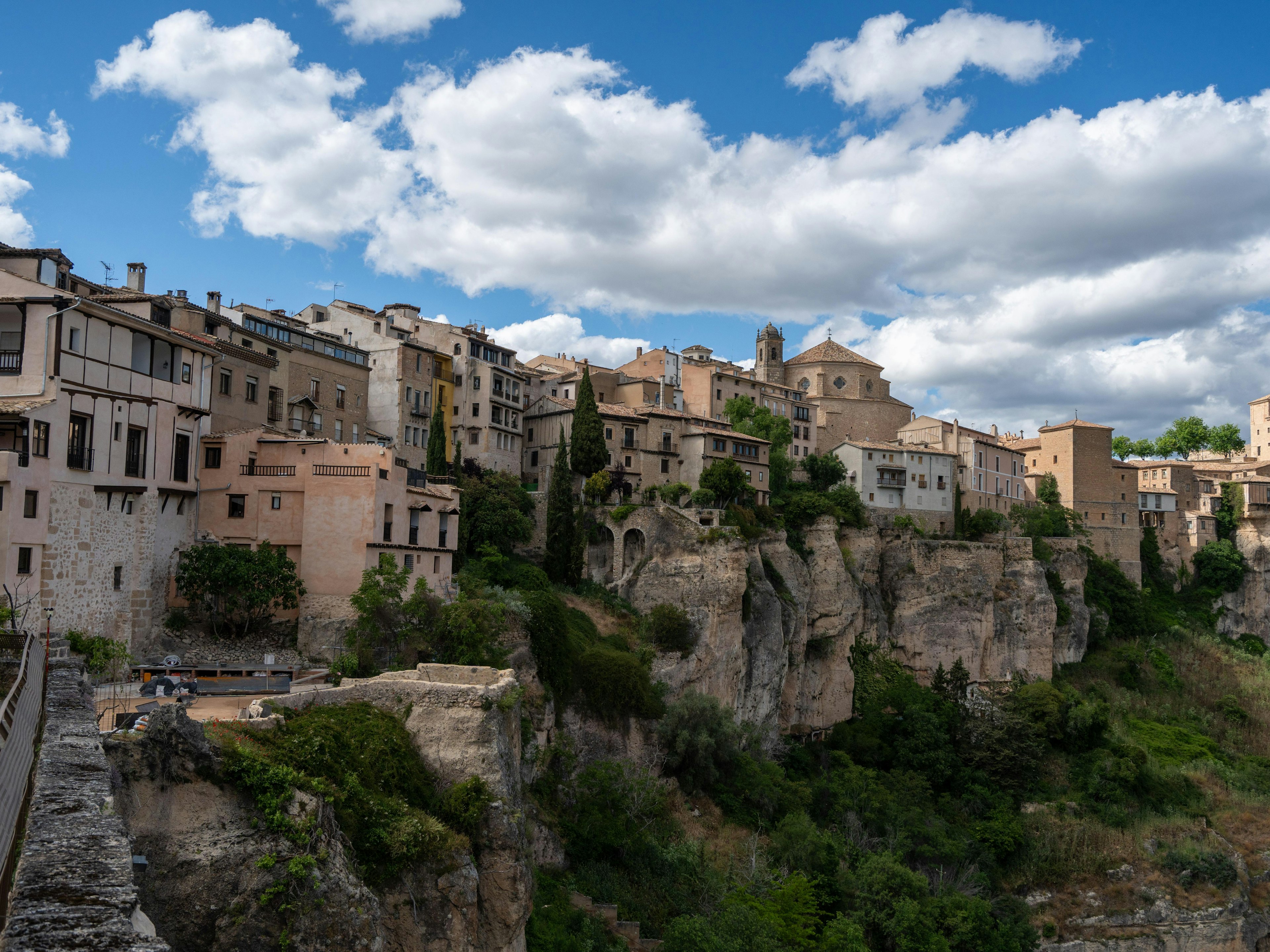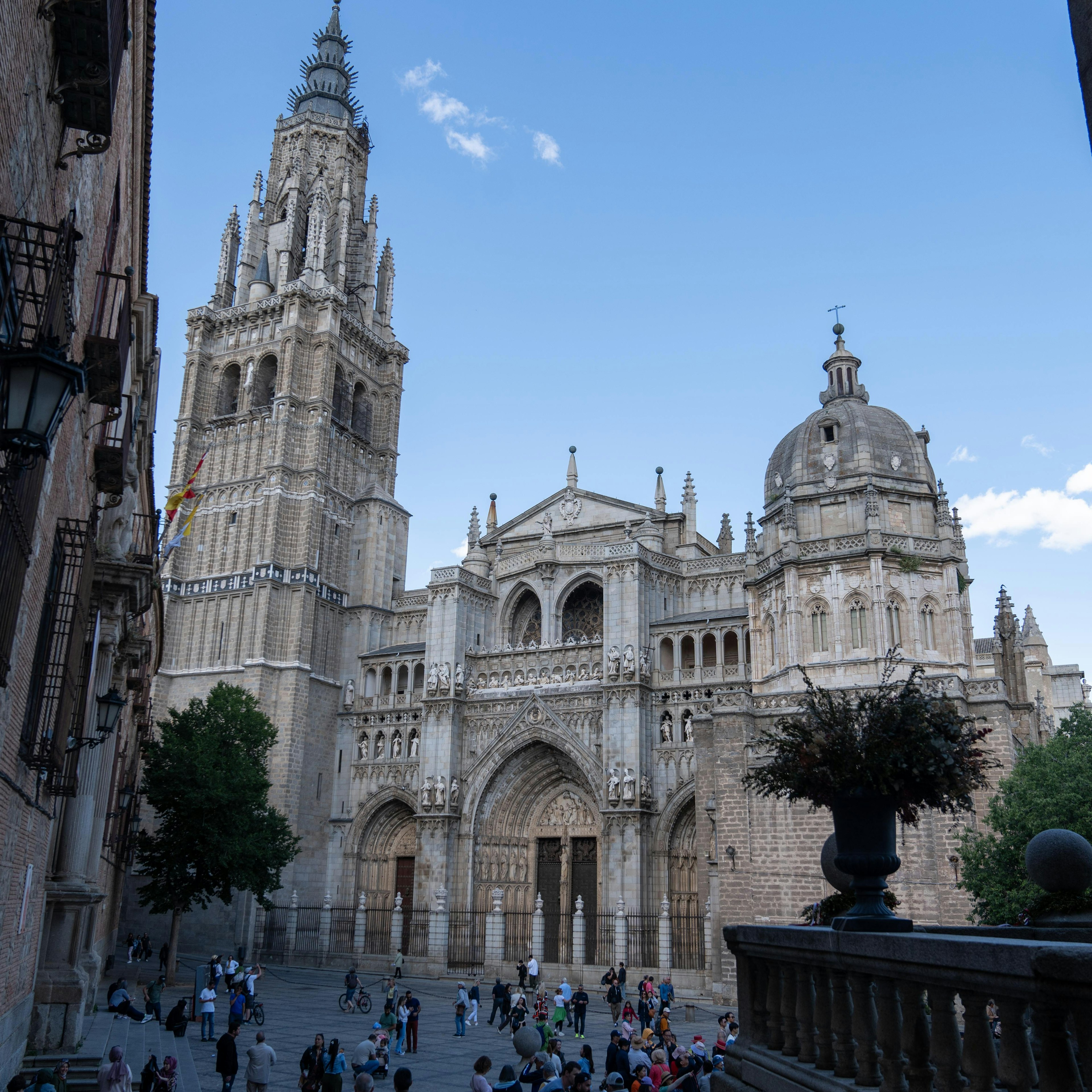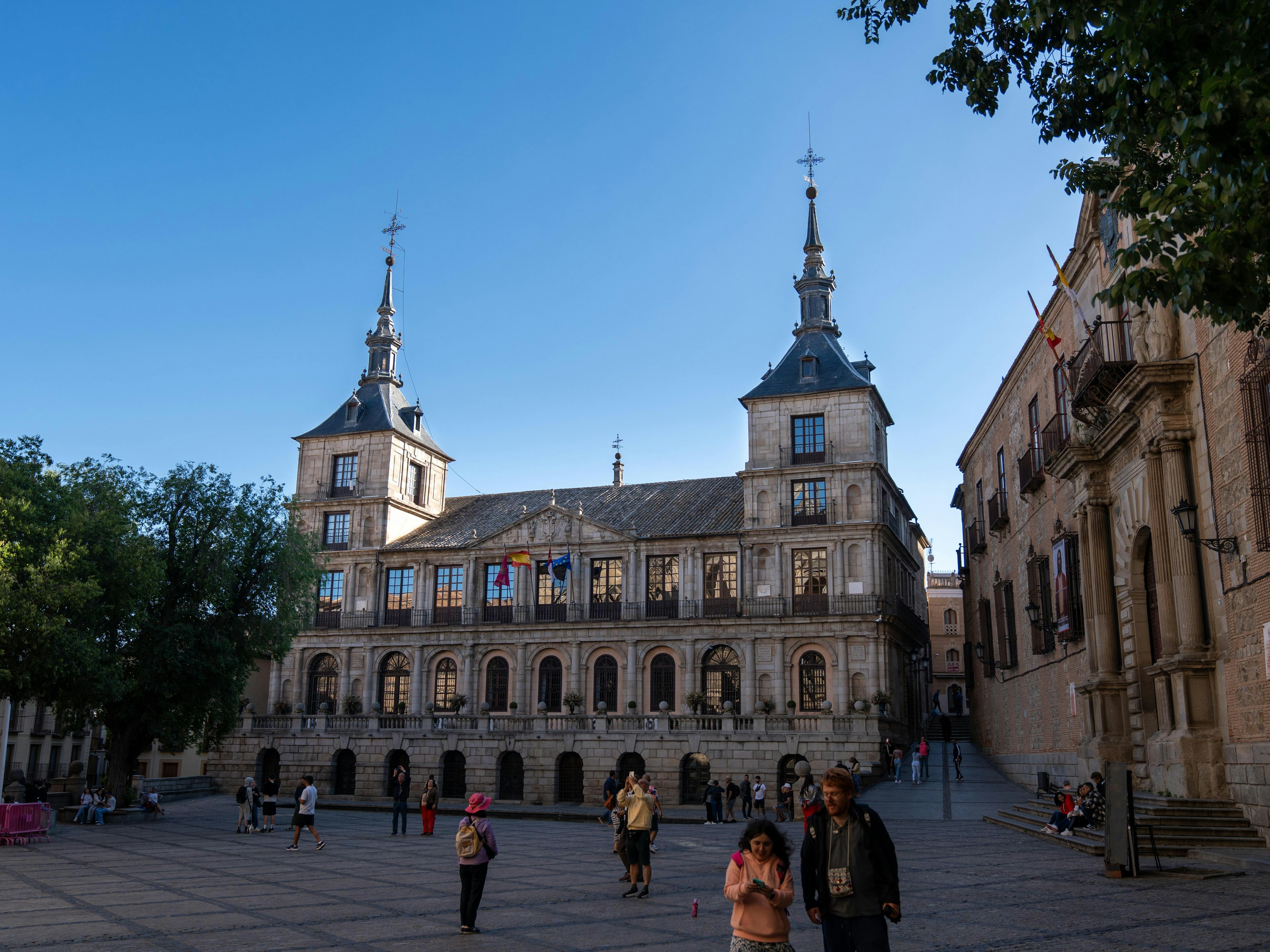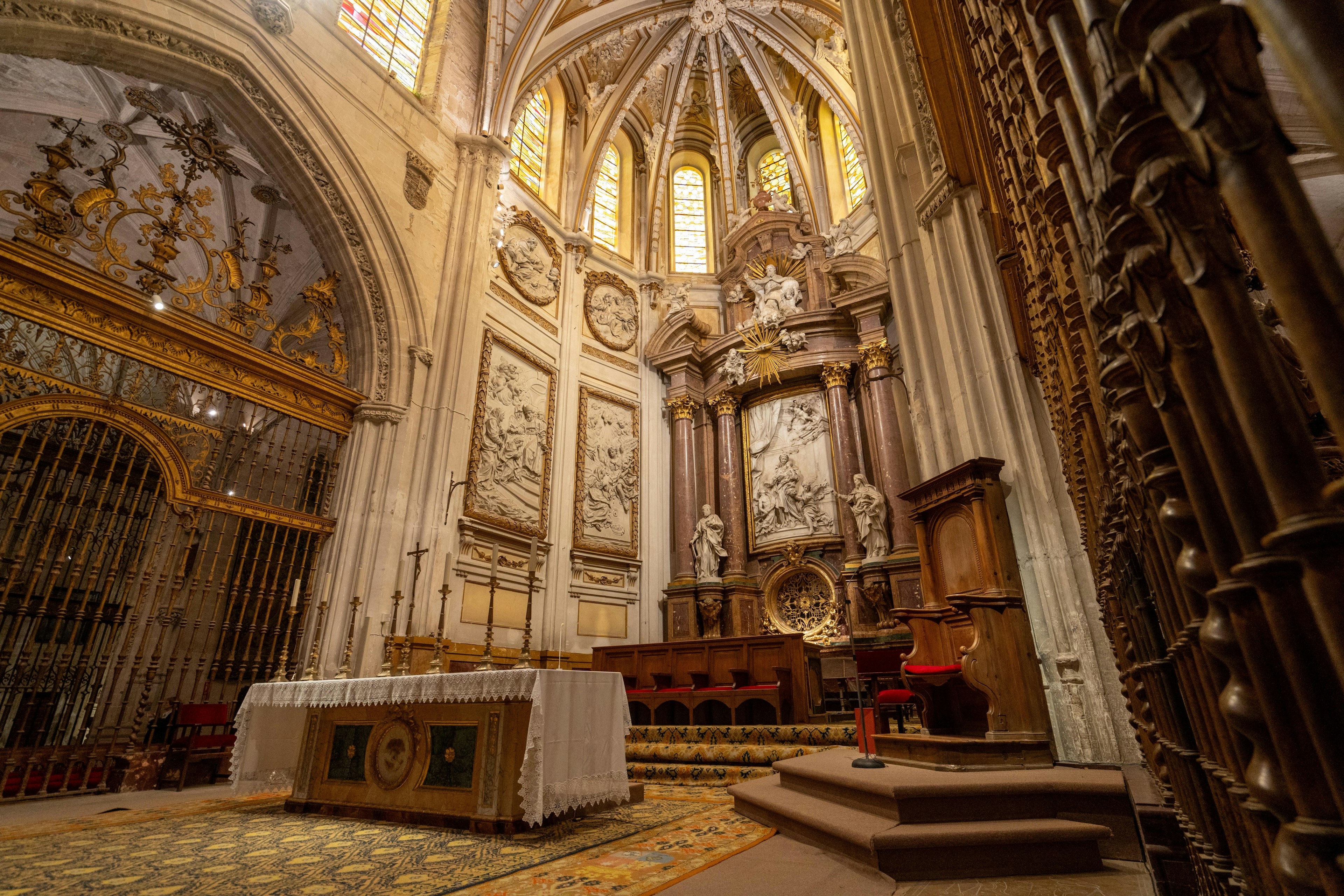
Architectural wonders of Cuenca and Toledo
Sponsored by

Jul 24, 2024 • 7 min read

The stories of history are set in stone and wood at the Catedral de Cuenca and other architectural gems of Castilla-La Mancha.
The historic cities of Cuenca and Toledo, both within easy reach of Madrid, are replete with some of Spain’s most striking centuries-old architectural treasures.
Toledo beguiles with its labyrinth of cobbled, hilly lanes, its Alcazar fortress, Renaissance and Gothic churches, Moorish mosques and synagogues hinting at past glories. Cuenca, dramatically hemmed in by the deep gorges of the Huécar and Júcar rivers, is surrounded by mountainous countryside. Besides its enchanting mix of Gothic, Baroque and medieval architecture, it is renowned for its casas colgadas – balconied abodes that dangle over one of the gorges.
Come with us as we take a walking tour of these jewels of Castilla La Mancha. To experience them at their best, it pays to visit on a weekday, and to linger overnight, once the day trippers have gone home.
Construction of the Catedral de Cuenca began in the 12th century, in the Gothic style. Blake Horn for Lonely Planet
Cuenca
In Cuenca, a UNESCO World Heritage Site, its evocative medieval buildings are packed into the rambling, narrow casco histórico (medieval city center) that sits on a steep promontory, bookended by river gorges. Begin your exploration at the Plaza Mayor; it is overlooked by the Baroque arches of the ayuntamiento (town hall) and the deceptively old-looking, neo-Gothic cathedral, built on the ruins of an 11th-century mosque, its present incarnation dating to 1902. Look out for its magnificent Renaissance doorway, abstract stained-glass windows and the intricate artesanado (wooden) ceiling in the chapter house.
Follow the dog-leg Calle Canónigos east of the plaza to Cuenca’s most famous attraction: the gabled casas colgadas (hanging houses), dating from the 14th century, that jut out precariously over the Río Huécar gorge. Continue downhill to the Puente de San Pablo footbridge for the best views of these extraordinary houses that seem to emerge from the rock like organic parts of the cliff, then retrace your steps.




One of the casas colgadas houses the artistic highlight of Cuenca – the Museo de Arte Abstracto, founded in the 1960s, and its airy galleries display an excellent collection of ethereal abstract canvases of Fernando Zóbel (the museum’s founder), thought-provoking pieces by Basque luminaries Jorge Oteiza, Eduardo Chillida and Néstor Basterretxea, and mixed-media paintings by Catalan heavyweight Antoni Tàpies.
From Plaza Mayor, take Calle San Pedro north to the Iglesia de San Pedro, Cuenca’s oldest church, though its current incarnation is from the 18th century. Highlights include its handsome Baroque façade, a coffered Mudéjar ceiling in one of the chapels, and the opportunity to scale the lofty belltower (former minaret) for stellar views of Cuenca. Next door is the labyrinthine 17th century Carmelite convent that houses the Fundación Antonio Pérez, a vast modern-art gallery with 1950s and '60s-era artists such as Antonio Saura, Manolo Millares and Lucebert well-represented.


A short walk further north, you get all-encompassing vistas of the surrounding area from the remains of the Castillo de Cuenca. A five-minute walk beyond the castle is the Mirador de la Hoz, where you can pick up the 2.5-mile-long Sendero Periferico de las Hoces de Cuenca and follow it along a spectacularly scenic route through both river gorges.

Toledo
Perched on a rocky mound overlooking the Río Tajo gorge, with every available inch covered in churches, horseshoe-arched mosques, Sephardic synagogues and houses, the ‘city of three cultures’ is magnificent.
During its many centuries of existence it has been a place where Christian, Muslim and Jewish communities coexisted peacefully, with Moorish craftsmen responsible for the some of the city’s finest edifices, and prominent Jews occupying positions of power in the royal court, before Toledo’s golden age as the capital of Castille came to an end in the 16th century, hot on the heels of the Inquisition’s mass expulsion of Jews and Moors. Toledo’s other claim to fame are the haunting canvasses of El Greco, one of the Old Masters, whose masterpieces are spread across Toledo’s many churches.


Begin your exploration of Toledo on the city’s east side, at the Plaza de Zocodover – the city’s beating heart, where toledanos gathered in centuries past to witness the Inquisition’s public burnings at the stake, or matadors performing their deadly dance during spirited bullfights. Uphill from the plaza is the Alcazar, Toledo’s highest point. Having begun its life as a 10th-century al-qasr (fortress), this formidable redoubt was rebuilt as a royal residence for Carlos I, reconstructed by Carlos V in the 16th century and then heavily bombarded by loyalist militias during the Spanish Civil War.
Head west from the Alcazar into the tangle of medieval lanes, passing the remnants of the 11th-century Mezquita de las Tornerías on its namesake street, before veering south to the Catedral de Toledo, a masterpiece of medieval Gothic architecture that took nearly 250 years (1227-1493) to complete. Step inside to appreciate its mélange of architectural styles: Gothic ribbed vaults and pointed arches; the sala capitular (chapter house), with its remarkable 500-year-old artesonado (wooden Mudéjar ceiling); the Gothic altarpiece of the Capilla Mayor with the wonderfully extravagant Churrigueresque Transparente just behind it; and the sacristía (sacristy), its gallery featuring a magnificent ceiling fresco, plus paintings by the likes of El Greco, Zurbarán, Caravaggio, Titian, Raphael and Velázquez.


Two blocks northwest of the cathedral is the 18th-century Iglesia de los Jesuitas with an imposing Baroque façade; climb the bell tower for magnificent views over Toledo.


Proceed along Calle de Alfonso XII to the Iglesia de Santo Tomé, home to El Greco’s most famous masterpiece: El entierro del conde de Orgaz (The Burial of the Count of Orgaz), accessed via the Plaza del Conde. The painting depicts the count’s funeral in 1322, with Sts Augustine and Stephen, along with El Greco himself, his son and Cervantes in attendance.
Further downhill along Calle de San Juan de Dios is Toledo's judería (old Jewish quarter). On Paseo del Tránsito you’ll find the Sinagoga del Tránsito, a synagogue built in 1355 by Samuel Levi, treasurer to Pedro I (Pedro the Cruel). Inside the galleried prayer hall with filigree windows and intricately carved pine ceiling is the Museo Sefardí, which provides a glimpse into Sephardic Jewish culture in Spain.
A block west of the Sinagoga del Tránsito is Toledo’s other surviving synagogue out of the ten that once dotted the judería, and one of only a handful of synagogues in Spain that have survived the expulsion of Jews from Spain in 1492. Built by Mudéjar craftsmen, the Sinagoga de Santa María La Blanca resembles a mosque, its four rows of pillars supporting horseshoe arches sporting intricate stuccowork, and its deep-red floors livened up with decorative ajulejos (tiles).
Proceed along Calle de los Reyes Católicos to the magnificent Monasterio San Juan de los Reyes, a Franciscan convent founded by Los Reyes Católicos, Fernando and Isabella, decorated in the Gothic Hispano-Flemish style, and particularly renowned for its two-story cloister with an elaborate Mudéjar ceiling and the crests of Castille and Aragón, symbolizing the unity of the royal marriage.
Finally, follow Calle Real along the medieval wall, and then the Subida Granja to wrap up your exploration at the Mezquita del Cristo de la Luz, a tiny 11th-century mosque (the only one remaining of Toledo's ten) that suffered the usual fate of being converted into a church, though its arches and vaulting are original Mudéjar work.

A new perspective: Illumination
Recent years have seen the rise of beautiful illumination shows around the world, and now you can see the architectural wonders of Toledo and Cuenca in a whole new way as well. These captivating displays make the Catedral de Toledo, and the Iglesia de San Miguel in Cuenca, even more vibrant – blending light, color, sound, and innovation to redefine the boundaries of architectural beauty.
The shows, Luz Cuenca and Lumina Catedral de Toledo, breathe life into the historic interiors, unveiling intricate details and hidden dimensions. The 45-50 minute nighttime tours feature both 2D and 3D animations that invite you to immerse yourself in a world where architecture transcends traditional boundaries and pulses with energy. You’ll experience the history and heritage of these classic buildings in a way you’ll remember forever.
Sponsored by Turismo Castilla-La Mancha
As a travel entertainment and inspirational media outlet, we sometimes incorporate brand sponsors into our efforts. This activity is clearly labeled across our platforms.
This story was crafted collaboratively between Turismo Castilla-La Mancha and Lonely Planet. Both parties provided research and curated content to produce this story. We disclose when information isn’t ours.
With sponsored content, both Lonely Planet and our brand partners have specific responsibilities:
Brand partner
Determines the concept, provides briefing, research material, and may provide feedback.
Lonely Planet
We provide expertise, firsthand insights, and verify with third-party sources when needed.
Explore related stories









 Cultural SiteSpanish agritourism: Rural experiences in La Rioja and beyond
Cultural SiteSpanish agritourism: Rural experiences in La Rioja and beyondJul 12, 2024 • 9 min read






